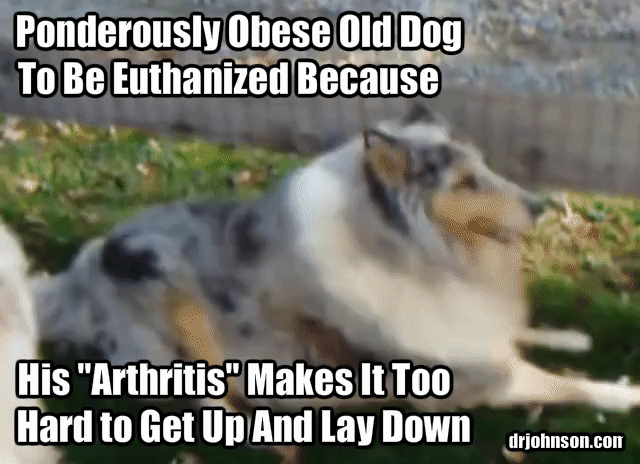What are the BIG Threats to Longevity in Dogs?
I’d like to do an article that describes “what really kills dogs“, or “What gets in the way of dog and cat longevity?”
There’s just so much stuff out there. With the advent of the Interwebs, veryone can sell advertising! 15 or 20 years ago it was just the major networks that could make money from a Nabisco ad. But now, anyone with Internet access, and enough of an audience can make money from advertisements running on their channel or web site. I’m fine with that.
The problem is that you have to have people (traffic) in your channel or website for those ads to make any difference, and so what you see is a lot of embellishment and hysteria and headline-grabbing and sensationalism; basically, which has been going on since the start of mankind.
Since EVERYTHING with dogs and cats is an overwhelming crisis, nowadays, how do you know what’s real?
I publish my longevity articles understanding that nobody’s really going to look at my stuff, and this has been borne out over and over again, because I don’t know how to trick Google into putting me at the top of the rankings and I’m not going to use headlines like “The president is dead“ to get people to click on my channel.
Don’t you think it’s funny that when Google started it was their job to be the best search engine there is. But now, instead of doing a good job of finding good information, they sit back and let the content provider come to THEM. It’s not about finding good content for them. It’s about content providers “toeing the line” and creating pages that Google “likes” whether there’s actually good content or not.
So what I’m going to do is write a quiet little article on pet longevity, what’s really killing cats and dogs based on experience in a suburban small animal practice.
Because it’s not dog food. And it’s not spay and neuter. And it’s not shots. Not hardly!
First, I’m going to brainstorm all the reasons dogs and cats died this last year.
- Extreme age and infirmity 75
- Cancer 35
- Complications from obesity 30
- Kidney failure 15
- Complications from Oral infections 7
- Biting and safety 6
- Hit by car and accident 6
- Heart disease 5
- Unexpected unexplained 3
There’s some overlap but not much. #2 is sometimes part of #1 and #4 and #8 find their root in #5.
Keep in mind that this is simply the number of cases that are subjectively assigned to a particular cause of death, from one little small animal practice in Marietta Georgia.
I think it sheds a lot of light on the reason people leave my clinic without a dog or cat (aka: pet expires or is put down).
What are the BIG Threats to Longevity in Dogs?
I noticed that a preponderance of animals face the end of life simply because they wear out. Their overall condition becomes so aged and infirm that quality-of-life is robbed from them.
As a distant second, lots of pets cross the rainbow bridge because of cancer, and a LOT of them have shortened longevity from complications from malignant obesity.
Many a day I will be putting asleep putting an animal to sleep that is considerably overweight and can’t get up. These dogs have carried the weight most of their lives, and into old age and then as their joints stiffen and their muscles weaken, they get down and cannot get up.
They pee on themselves, and in the house, and there is no dignity, and we put them down.
That is a commentary on overweight in dogs as they move into their twilight years. “Overweight past eight” – just doesn’t go well for them.

On the other hand, it’s never too late to start, putting them on Atkins diet which is essentially Paleo. Ultra low-carb feeding getting the carbohydrate fraction down to 10% or less eating eggs and non-starch vegetables with a little pumpkin stirred in for soluble fiber.
And, administering DHEA to these pets to shave her weight off of them. This can add as many as three years to the longevity of some of the larger patients, as their physical abilities deteriorate with age.
DHEA
This is a pseudo-hormone that can restore many of the metabolic benefits of the sex hormones like testosterone and estrogen to the dog, increasing resistance to cancer, and aiding in the metabolic acceleration of weight loss.
Establishing thyroid status
Many older animals are hypo thyroid and when that is corrected, they get a new lease on their metabolism, a big boost to longevity and weight loss is remarkable.
Feeding ultra low-carb, once known as Atkins, achieved amazing weight loss, suppression of the ravenous appetite after several months, and extraordinary benefits to overall health.
I will never mention feeding dogs Atkin’s style, without simultaneously mentioning that when people feed their dog Atkin’s style, but also give carbohydrate treats and table food on the side, that will kill the dog! Atkins style feeding is high protein and significant amounts of fat, and if given with carbohydrates, the fat is deposited and the animals become PONDEROUS.

It is difficult to contemplate the extension of life through weight loss if pain remains. Who wants to extend a painful life?
Allow me to take a moment to describe an “arthritis diagnostic” regimen that I am very fond of.
We take an animal in reasonable health, we put them on three medications to ameliorate arthritis in order to see how much of an impact arthritis is actually having on the dog.
Let me explain that:
If you put a dog on medicines for
- pain
- inflammation
- nerve pinching
- bone-on-bone grinding
…and you don’t see any difference in the dog, it suggests that these issues don’t manifest in the dog. That he doesn’t need those medicines.
However, if you use a comprehensive panel of medications for a week that address most causes of discomfort in elderly dogs and it’s “the best week of his life“ then you know you have a candidate for long-range arthritis management. You can’t tell a dog in back pain, it does NOT cause limping, right? How can you tell if they have a sore neck? They can’t tell you and it doesn’t cause a limp.
But when they respond to empirical arthritis / nerve pain medications “tried for a week” – these are exciting cases.
Quite often, it’s not necessary to use all three of those medications all the time once you know that arthritis is a factor and can be controlled, you can reduce the amounts and frequency of certain medications and still get excellent results.
The key is the initial diagnosis based on therapeutic response.
The initial cocktail does not include a painkiller. No narcotics, as I do not want to mask the pain, in this protocol I want to alleviate it.
We use Deramax, methocarbamol, and gabapentin. Depending on the pet, we may also use a stomach protectant like famotidine or omeprazole.
After the first week, if the Pet is doing very well we may continue to manage him or her using the following protocols:
Perpetual low-dose gabapentin, perpetual low dose methocarbamol, and “as needed“ Deramax. There is economy and safety in that message.
Some people are so crazy about the way their dog is feeling on the three medications given every day, that they decide to stay with that, and it is perfectly OK.
Most vets will bother you every six months for blood work to check to make sure nothing is happening with the kidneys and liver on the nonsteroidal anti-inflammatory.





